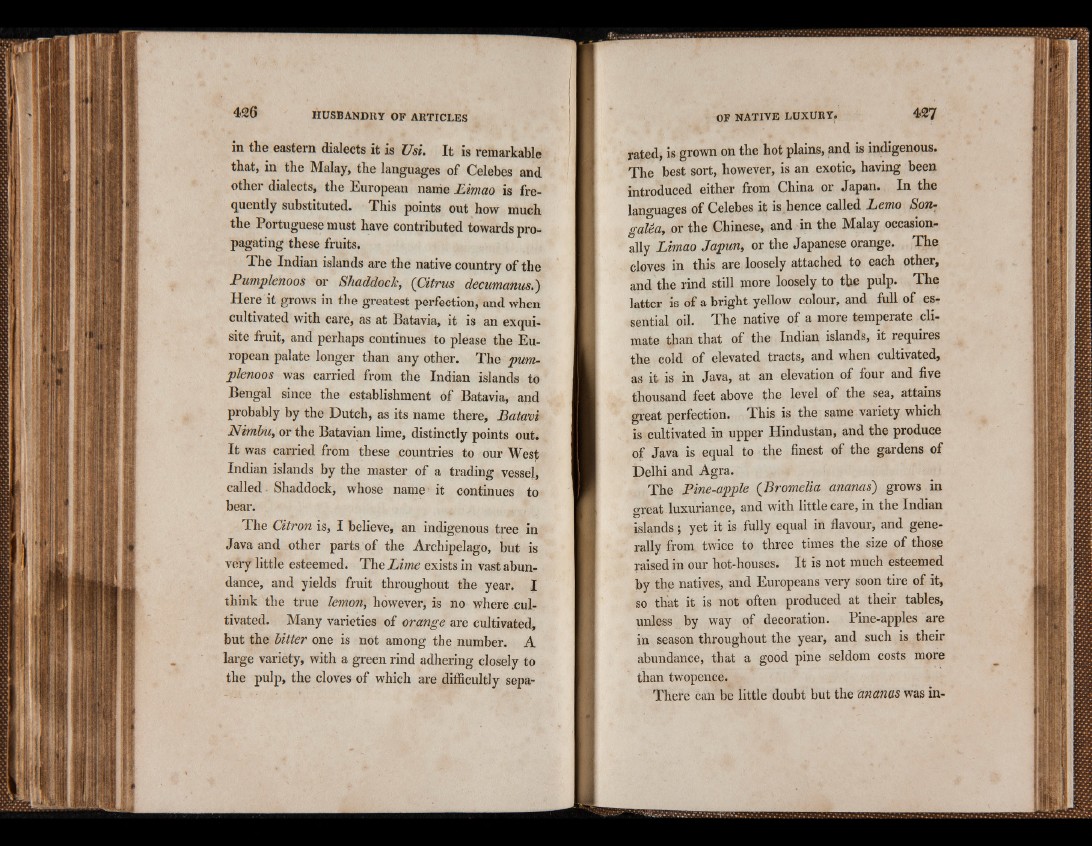
in the eastern dialects it is Usi. It is remarkable
that, in the Malay, the languages of Celebes and
other dialects, the European name Limao is frequently
substituted. This points out how much
the Portuguese must have contributed towards propagating
these fruits.
The Indian islands are the native country of the
Pumplenoos or Shaddock, (Citrus decumanus.)
Here it grows in the greatest perfection, and when
cultivated with care, as at Batavia, it is an exquisite
fruit, and perhaps continues to please the European
palate longer than any other. The pumplenoos
was carried from the Indian islands to
Bengal since the establishment of Batavia, and
probably by the Duteh, as its name there, Batavi
Nimbu, or the Batavian lime, distinctly points out.
It was carried from these countries to our West
Indian islands by the master of a trading vessel,
called. Shaddock, whose name it continues to
bear.
The Citron is, I believe, an indigenous tree in
Java and other parts of the Archipelago, but is
very little esteemed. The Lime exists in vast abundance,
and yields fruit throughout the year. I
think the true lemon, however, is no where cultivated.
Many varieties of orange are cultivated,
but the bitter one is not among the number. A
large variety, with a green rind adhering closely to
the pulp, the cloves of which are difficultly separated,
is grown on the hot plains, and is indigenous.
The best sort, however, is an exotic, having been
introduced either from China or Japan. In the
languages of Celebes it is hence called Lemo Son-
galea, or the Chinese, and in the Malay occasionally
Limao Japun, or the Japanese orange. The
cloves in this are loosely attached to each other,
and the rind still more loosely to the pulp. The
latter is of a bright yellow colour, and full of essential
oil. The native of a more temperate climate
than that of the Indian islands, it requires
the cold of elevated tracts, and when cultivated,
as it is in Java, at an elevation of four and five
thousand feet above the level of the sea, attains
great perfection. This is the same variety which
is cultivated in upper Hindustan, and the produce
of Java is equal to the finest of the gardens of
Delhi and Agra.
The Pine-apple (Bromelia ananas) grows in
great luxuriance, and with little care, in the Indian
islands; yet it is fully equal in flavour, and generally
from twice to three times the size of those
raised in our hot-houses. It is not much esteemed
by the natives, and Europeans very soon tire of it,
so that it is not often produced at their tables,
unless by way of decoration. Pine-apples are
in season throughout the year, and such is their
abundance, that a good pine seldom costs more
than twopence.
There can be little doubt but the ananas was in